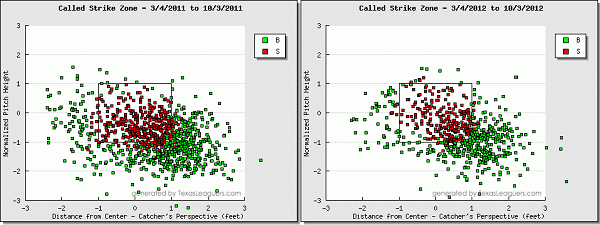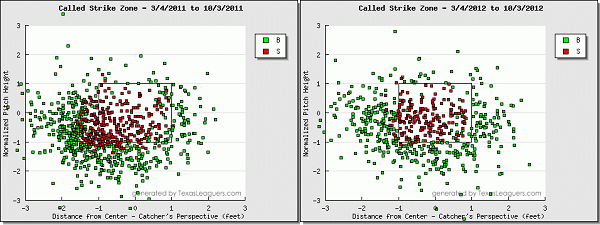Setting a Derek Lowe Baseline
Kyle Lohse is a free-agent starting pitcher, and the Texas Rangers are a good baseball team, so off and on there’s been talk about the Rangers potentially making an effort to sign Kyle Lohse. This has picked up in light of the recent Martin Perez injury, as Perez was the favorite to be the Rangers’ fifth starter. Lohse, though, remains unsigned, and it looks like the Rangers might be on the verge of going elsewhere for help:
Source: Rangers on verge of signing RHP Derek Lowe to minor league deal, but he will make club, probably in swing role. Story coming.
— Evan Grant (@Evan_P_Grant) March 6, 2013
It’s not done, but it’s probably close, if this is the report. It makes a certain degree of sense, too — Lowe could offer short-term services to the rotation, and then get bumped upon the return of Perez or Colby Lewis. Lowe pitched out of the rotation and bullpen a year ago, and he’ll be a cheap investment for a team scared off by Lohse’s price tag. Lowe would cost the Rangers something in the low seven figures, most probably, with some incentives, most probably.
Why is Lowe signing a minor-league contract in March? Because last season, his numbers were bad. Also he’s months away from 40. But mostly the first thing, as no other starter in baseball generated a lower strikeout rate. Lowe wasn’t a disaster with the Indians, but he was ineffective and he closed the year pitching in relief for the Yankees.
Yet, though Lowe is old, and though Lowe is coming off a bad statistical season, as recently as 2011 he was arguably better than Lohse. In the same number of innings, Lowe posted a higher ERA, but an identical FIP and a lower xFIP. It wasn’t long ago that Derek Lowe was pretty good, and in fact he was pretty consistently good. In 1998, according to his FanGraphs player page, Lowe was worth 2.9 WAR. All the way through 2011, he didn’t have a single sub-2-WAR season. Between 2009-2011, Lowe was a little better than average, generating enough strikeouts to go with his trademark grounders. You can see why the Rangers might be intrigued by Lowe — at a modest price, Lowe could be a half-decent innings-eater with enough sink to keep the ball out of the Texas air. Why pay for Lohse if you don’t necessarily have to?
But I have questions about Lowe, about what he actually is and has been. This is along similar lines as a previous post about Justin Masterson, except from the opposite side. Just where do we set our Derek Lowe performance baseline? What has he actually been, as a pitcher? I think that Lowe’s catchers have to be taken into consideration.
Last year, Lowe threw mainly to Carlos Santana and Lou Marson. The three previous years, he threw almost exclusively to Brian McCann and David Ross. In 2008, he threw to Russell Martin. Martin, McCann, and Ross appear to be good pitch-framers, according to the numbers. Santana and Marson appear to be poor pitch-framers. It’s interesting that Lowe’s numbers took a dive once he started pitching to considerably worse receivers.
I’d like to take you back to a post from December. It wasn’t supposed to be about Derek Lowe, but part of it kind of was about Derek Lowe. I calculated a stat called Diff/1000 — the difference between actual strikes and expected strikes, per 1,000 called pitches. I adjusted to set the league average to zero. Here’s how Lowe came out during the PITCHf/x era:
2008: +72
2009: +89
2010: +85
2011: +89
2012: -8
Put another way:
2008: amazing
2009: amazing
2010: amazing
2011: amazing
2012: whoopsadoodle
For the first four years of the observed window, Lowe was being given way more strikes than you’d expect, based on the PITCHf/x strike zone. Last year, that edge disappeared, and Lowe’s numbers tumbled. Let’s also look at Lowe’s numbers available on StatCorner. Here, zTkB% is the rate of pitches in the strike zone taken for a ball, and oTkS% is the rate of pitches out of the strike zone taken for a strike. The StatCorner strike zone, one must note, is not based on the rulebook strike zone. It’s based on an average of all the actual umpire strike zones, so it looks a little different. A table, comparing Lowe as a starter to the league averages:
| Year | zTkB% | Lg zTkB% | oTkS% | Lg oTkS% |
|---|---|---|---|---|
| 2008 | 10% | 19% | 13% | 8% |
| 2009 | 7% | 17% | 12% | 8% |
| 2010 | 7% | 14% | 13% | 9% |
| 2011 | 9% | 14% | 13% | 8% |
| 2012 | 16% | 15% | 5% | 7% |
For four years, Lowe got a lot more strikes in the zone, and he got a lot more strikes out of the zone. Last year, he got slightly fewer strikes in the zone, and fewer strikes out of the zone. The differences are dramatic, and impossible to think of as negligible. Presumably, this doesn’t explain everything, but this should explain some of what we observe in Lowe’s statistics.
Used to be that Lowe was accustomed to getting the low strike, and also getting some strikes off the rulebook edges. A lot of that just disappeared in 2012. Via Texas Leaguers, some images:
Lowe called strike zone against right-handed batters, 2011 on left, 2012 on right
Lowe called strike zone against left-handed batters, 2011 on left, 2012 on right
The very short of it: Lowe went from pitching to good framers to worse framers. The numbers suggest he pitched to a smaller strike zone, and his statistics became much worse. It doesn’t appear that Lowe’s actual stuff was any worse than usual. I think the truth is that Lowe was a better pitcher in 2012 than his numbers, and previously he was a worse pitcher than his numbers. He used to get a lot of help from his receivers, even if Lowe was somewhat responsible for that, so perhaps he was overdue for opposite treatment.
So, for the Rangers, this would be good news and bad news. The good news is that, yeah, Lowe probably isn’t as bad as he looked in 2012. He can still throw those sinkers and he can still throw around the edges. The bad news is that Lowe probably isn’t the guy his Atlanta numbers suggest he was. He isn’t throwing to McCann and Ross anymore. He’s not throwing to Martin anymore. With fewer low strikes and off-the-edge strikes, Lowe wouldn’t pitch with the same advantage.
But with a little improvement on the 2012 statistics, Lowe still makes for a swingman of utility. The grounders haven’t betrayed him, and Lowe would be pitching to A.J. Pierzynski and Geovany Soto. A table of particular interest:
| Catcher | zTkB% | oTkS% |
|---|---|---|
| McCann | 13% | 10% |
| Ross | 13% | 11% |
| Marson | 19% | 6% |
| Santana | 19% | 6% |
| Pierzynski | 18% | 8% |
| Soto | 15% | 8% |
Pierzynski and Soto aren’t McCann and Ross, but they also aren’t Marson and Santana. They’re better receivers, which would allow Lowe to pitch to more of an advantage.
Additionally, Lowe would be supported in the infield by Mitch Moreland, Ian Kinsler, Elvis Andrus, and Adrian Beltre. There might be better defensive infields in baseball, but there aren’t any way better defensive infields in baseball, so Lowe would be in position to have more of his balls in play turn into outs. In a hitter-friendly environment, it’s good to have groundball pitchers. It’s extra good to have groundball pitchers if you have guys who can track down groundballs.
There’s upside here, for the Rangers. Not a lot of it — Lowe probably isn’t going to go back to posting the numbers he used to — but he doesn’t need to post those old numbers to be useful and effective. With better receivers and a better infield, he should look like a better pitcher, and you could do worse as insurance. You could even end up with something that looks like a bit of a steal. That’s not something that’s often said about a guy coming off a league-low strikeout rate, but, here we are.
Jeff made Lookout Landing a thing, but he does not still write there about the Mariners. He does write here, sometimes about the Mariners, but usually not.


It would be very opimistic to expect Lowe to be an improvement over a rookie.